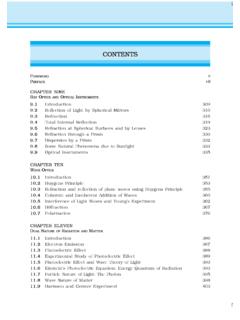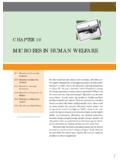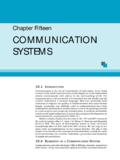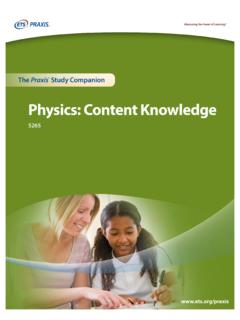Transcription of Chapter Four MOVING CHARGES AND MAGNETISM
1 INTRODUCTIONBoth Electricity and MAGNETISM have been known for more than 2000years. However, it was only about 200 years ago, in 1820, that it wasrealised that they were intimately related*. During a lecture demonstrationin the summer of 1820, the Danish physicist Hans Christian Oerstednoticed that a current in a straight wire caused a noticeable deflection ina nearby magnetic compass needle. He investigated this found that the alignment of the needle is tangential to an imaginarycircle which has the straight wire as its centre and has its planeperpendicular to the wire. This situation is depicted in (a). It isnoticeable when the current is large and the needle sufficiently close tothe wire so that the earth s magnetic field may be ignored.
2 Reversing thedirection of the current reverses the orientation of the needle [Fig. (b)].The deflection increases on increasing the current or bringing the needlecloser to the wire. Iron filings sprinkled around the wire arrangethemselves in concentric circles with the wire as the centre [Fig. (c)].Oersted concluded that MOVING CHARGES or currents produced amagnetic field in the surrounding this there was intense experimentation. In 1864, the lawsobeyed by electricity and MAGNETISM were unified and formulated byChapter FourMOVING CHARGESAND MAGNETISM *See the box in Chapter 1, Page CHARGES andMagnetism133 James Maxwell who then realised that light was electromagnetic waves were discovered by Hertz, and produced by andG.
3 Marconi by the end of the 19th century. A remarkable scientific andtechnological progress has taken place in the 20th century. This is due toour increased understanding of electromagnetism and the invention ofdevices for production, amplification, transmission and detection ofelectromagnetic this Chapter , we will see how magnetic field exertsforces on MOVING charged particles, like electrons,protons, and current-carrying wires. We shall also learnhow currents produce magnetic fields. We shall see howparticles can be accelerated to very high energies in acyclotron. We shall study how currents and voltages aredetected by a this and subsequent Chapter on MAGNETISM ,we adopt the following convention: A current or afield (electric or magnetic) emerging out of the plane of thepaper is depicted by a dot ( ).
4 A current or a field goinginto the plane of the paper is depicted by a cross ( )*.Figures. (a) and (b) correspond to these twosituations, MAGNETIC Sources and fieldsBefore we introduce the concept of a magnetic field B, weshall recapitulate what we have learnt in Chapter 1 aboutthe electric field E. We have seen that the interactionbetween two CHARGES can be considered in two charge Q, the source of the field, produces an electricfield E, whereFIGURE The magnetic field due to a straight long current-carryingwire. The wire is perpendicular to the plane of the paper. A ring ofcompass needles surrounds the wire. The orientation of the needles isshown when (a) the current emerges out of the plane of the paper,(b) the current moves into the plane of the paper.
5 (c) The arrangement ofiron filings around the wire. The darkened ends of the needle representnorth poles. The effect of the earth s magnetic field is Christian Oersted(1777 1851) Danishphysicist and chemist,professor at observed that acompass needle suffers adeflection when placednear a wire carrying anelectric current. Thisdiscovery gave the firstempirical evidence of aconnection between electricand magnetic CHRISTIAN OERSTED (1777 1851)*A dot appears like the tip of an arrow pointed at you, a cross is like the featheredtail of an arrow MOVING away from = Q r/ (4 0)r2( )where r is unit vector along r, and the field E is a vectorfield.
6 A charge q interacts with this field and experiencesa force F given by F = q E = q Q r / (4 0) r2( )As pointed out in the Chapter 1, the field E is notjust an artefact but has a physical role. It can conveyenergy and momentum and is not establishedinstantaneously but takes finite time to propagate. Theconcept of a field was specially stressed by Faraday andwas incorporated by Maxwell in his unification ofelectricity and MAGNETISM . In addition to depending oneach point in space, it can also vary with time, , be afunction of time. In our discussions in this Chapter , wewill assume that the fields do not change with field at a particular point can be due to one ormore CHARGES .
7 If there are more CHARGES the fields addvectorially. You have already learnt in Chapter 1 that thisis called the principle of superposition. Once the field isknown, the force on a test charge is given by Eq. ( ).Just as static CHARGES produce an electric field, thecurrents or MOVING CHARGES produce (in addition) amagnetic field, denoted by B (r), again a vector field. Ithas several basic properties identical to the electric is defined at each point in space (and can in additiondepend on time). Experimentally, it is found to obey theprinciple of superposition: the magnetic field of severalsources is the vector addition of magnetic field of eachindividual Magnetic Field, Lorentz ForceLet us suppose that there is a point charge q (movingwith a velocity v and, located at r at a given time t) inpresence of both the electric field E (r) and the magneticfield B (r).
8 The force on an electric charge q due to both ofthem can be written asF = q [ E (r) + v B (r)] Felectric +Fmagnetic( )This force was given first by Lorentz based on the extensiveexperiments of Ampere and others. It is called the Lorentz force. Youhave already studied in detail the force due to the electric field. If welook at the interaction with the magnetic field, we find the followingfeatures.(i) It depends on q, v and B (charge of the particle, the velocity and themagnetic field). Force on a negative charge is opposite to that on apositive charge.(ii)The magnetic force q [ v B ] includes a vector product of velocityand magnetic field. The vector product makes the force due to magneticHENDRIK ANTOON LORENTZ (1853 1928)Hendrik Antoon Lorentz(1853 1928) Dutchtheoretical physicist,professor at Leiden.
9 Heinvestigated therelationship betweenelectricity, MAGNETISM , andmechanics. In order toexplain the observed effectof magnetic fields onemitters of light (Zeemaneffect), he postulated theexistence of electric chargesin the atom, for which hewas awarded the Nobel Prizein 1902. He derived a set oftransformation equations(known after him, asLorentz transformationequations) by some tangledmathematical arguments,but he was not aware thatthese equations hinge on anew concept of space CHARGES andMagnetism135field vanish (become zero) if velocity and magnetic field are parallelor anti-parallel. The force acts in a (sideways) direction perpendicularto both the velocity and the magnetic direction is given by the screw rule orright hand rule for vector (or cross) productas illustrated in Fig.
10 (iii)The magnetic force is zero if charge is notmoving (as then |v|= 0). Only a movingcharge feels the magnetic expression for the magnetic force helpsus to define the unit of the magnetic field, ifone takes q, F and v, all to be unity in the forceequation F = q [ v B] =q v B sin n, where is the angle between v and B [see Fig. (a)].The magnitude of magnetic field B is 1 SI unit,when the force acting on a unit charge (1 C), MOVING perpendicular to B with a speed 1m/s,is one , we have [B] = [F/qv] and the unitof B are Newton second / (coulomb metre). Thisunit is called tesla ( T ) named after Nikola Tesla(1856 1943). Tesla is a rather large unit. A smaller unit (non-SI) calledgauss (=10 4 tesla) is also often used.












